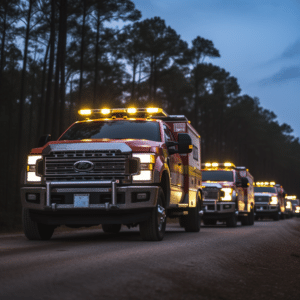Tragedy Revisited: Reflecting on the Carrollton Bus Collision Aftermath
Last updated Monday, December 4th, 2023

The Carrollton bus collision, a heart-wrenching tragedy that occurred on May 14, 1988, continues to haunt the memories of the survivors and the families of the 27 lives lost. The catastrophic event sparked a nationwide movement to address the dangers of drunk driving and the safety regulations surrounding buses. This blog post delves into the chilling details of that fateful day, the investigative findings, and the lasting impact on legislation and public awareness.
Get Your FREE Case Review Today
Contact us today and we will help you get the compensation that you deserve.
or Send Us Your Case DetailsGet Your FREE Case Review Today
Contact us today and we will help you get the compensation that you deserve.
or Send Us Your Case DetailsThe Tragic Day at Carrollton
In 1988, a church youth group from the Assembly of God church in Radcliff, Kentucky, set off for a trip to Kings Island Amusement Park in the Ohio region with great enthusiasm. Little did they know that their return journey would end in one of the deadliest bus collisions in US history.
After a day filled with amusement at the park, the group, consisting of 66 passengers and a driver, boarded their bus and started their content return journey to Radcliff.
Prelude to Disaster
The group was traveling in a 1977 Ford B700, previously a school bus, not originally designed to accommodate the safety needs of the number of passengers on board. The bus was intended for 66 passengers and a driver, but its safety features were inadequate for this capacity.
Despite the principal pastor of the Radcliff First Assembly of God church limiting the ridership of the church bus to the legal limit, the bus’s design still posed a significant risk to its passengers.
The Collision Unfolds
As the bus traveled southbound on Interstate 71, the unthinkable happened – a fatal bus crash. The bus collided in a head on collision with a black 1987 Toyota pickup truck driven by a drunk driver, Larry Wayne Mahoney, who was speeding in the wrong direction on the highway. The right front suspension of the Ford chassis broke off through the bus stepwell, causing a horrific impact. The punctured gasoline tank ignited the fuel supply, resulting in further damage. In an instant, the bus was engulfed in flames, trapping many passengers inside as the doors were jammed shut.
Bus driver John Pearman, an associate pastor of the church, attempted to extinguish the flames using a small fire extinguisher, while passengers scrambled to evacuate through the center rear emergency door and the front door. Despite their desperate efforts, the fire and smoke claimed the lives of 27 people, including 24 children and three adults. The heart-wrenching scene that unfolded on that tragic night would leave a lasting impact on the survivors, their families, and the world.
Emergency Response

- The risk of fire
- Multiple persons trapped
- A range of injuries
- The need to render the site safe from traffic
- The limited number of emergency exits on the bus, which made it difficult for passengers to escape the inferno.
Medical professionals provided treatment to burn victims at the scene, with the most severe injuries being treated in the emergency room or surgery recovery room. The emotional and physical toll of the night would forever be etched in the memories of the responders, who were tasked with the grim duty of saving lives and bearing witness to the devastating aftermath of the collision.
The Heartbreaking Toll
The Carrollton bus collision left an indelible mark on the community, with 27 lives lost, and many others forever changed. The victims, mostly children aged between 13 and 14, came from families who never imagined that a fun outing would end in such devastation.
The survivors and their families are still wrestling with the emotional wounds and the haunting memories of that tragic night.
Remembering the Lives Lost
As the years pass, the victims of the Carrollton bus collision are remembered through various memorials and commemorations. A memorial stone dedicated to the victims and survivors of the crash serves as a solemn reminder of the lives lost. Annual memorial services are held to mark the anniversary of the tragedy, where prayers, songs, and personal stories are shared by the survivors and their loved ones.
The youngest victims of the crash, who ranged in age from 10 to 19 years old, are particularly mourned by their families and the community. Their untimely deaths serve as a stark reminder of the dangers of drunk driving and the importance of strict safety regulations for buses.
Survivors’ Stories
Survivors of the Carrollton bus collision persist in sharing their experiences, emphasizing the enduring impact of the tragedy on their lives. They recount the harrowing moments of the crash, the ensuing chaos, and the emotional toll it has taken on them and their families. For many, the physical and emotional scars remain, as they continue to grapple with the memories and emotions tied to the incident.
The survivors’ stories not only serve as a testament to their resilience but also as a powerful call to action for stricter safety regulations and increased awareness about the dangers of drunk driving. Their voices carry the weight of the lives lost and the hope for a safer future.
Investigative Insights
The investigation into the Carrollton bus collision brought to light major safety concerns and resulted in legal repercussions for the drunk driver, Larry Mahoney. The National Transportation Safety Board (NTSB) and other organizations conducted extensive investigations into the accident’s causes and the safety standards of the bus.
The NTSB Report
The NTSB report concluded that the bus’s design contributed to the fatalities, prompting calls for stricter safety standards. The report found that the unprotected fuel tank, flammable seat covers, and partially obstructed rear exit were among the design flaws that exacerbated the tragedy.
These findings, along with the tragic loss of life, served as a catalyst for change in bus safety regulations and drunk driving laws. The NTSB’s recommendations would have a lasting impact on the safety standards and regulations for buses in Kentucky and across the nation.
Legal Repercussions for Larry Mahoney
Larry Mahoney, the drunk driver responsible for the collision, was found guilty of 27 counts of manslaughter. He started his prison sentence in 1998. He finished it 10 years and 11 months later in 1999. However, his drunk driving charge was later reversed on appeal, a decision that sparked controversy and further fueled calls for stricter drunk driving laws.
The legal consequences for Mahoney served as a cautionary tale for those who choose to drive under the influence. The incident and its aftermath ultimately led to significant changes in drunk driving laws and bus safety regulations in Kentucky and beyond.
Legislative Legacy
The Carrollton bus collision instigated major legislative changes both in Kentucky and nationwide. In response to the tragedy, lawmakers implemented stricter bus safety regulations and drunk driving laws, aiming to prevent similar incidents in the future.
Kentucky’s Response
In response to the tragedy, Kentucky implemented stricter bus safety regulations, such as protected gas tank, non-flammable bus seat material, and an increased number of emergency exits. These changes aimed to address the design flaws identified in the NTSB report and improve overall bus safety.
Kentucky also enacted harsher penalties for drunk driving, including mandatory ignition interlock systems for certain DUI offenders. These changes have been effective in reducing similar incidents and increasing overall traffic safety in the state.
Nationwide Impact
The Carrollton bus collision also influenced nationwide policies, leading to the establishment of stricter standards for buses and punishments for drunk driving. The incident served as a wake-up call for the nation, prompting a reevaluation of bus safety regulations and drunk driving laws.
The reduction in the legally impaired blood alcohol level from .15 to .08 and the implementation of stricter safety standards for buses are just a few examples of the nationwide impact of the Carrollton tragedy. The harrowing event and its aftermath continue to serve as a reminder of the importance of safety regulations and the dangers of drunk driving.
Commemorating the Victims
The victims of the Carrollton bus collision are remembered in various ways, including through monuments, memorial services, and advocacy efforts. These commemorations serve as a tribute to the lives lost and a reminder of the need for continued vigilance in the fight against drunk driving.
Monuments and Memorials
Ford Motor Company funded the installation of a black marble monument in North Hardin Memorial Gardens Cemetery, located in Radcliff, Kentucky. It serves as an iconic reminder of departed loved ones for local families. This solemn memorial stands as a testament to the lives lost in the tragedy and serves as a place for families and the community to pay their respects.
Annual memorial services are held to mark the anniversary of the collision, where survivors and loved ones gather to remember the victims, share their stories, and offer support to one another. These events not only honor the lives lost but also remind us of the importance of safety regulations and the need for continued efforts to prevent drunk driving.
Advocacy and Awareness
Survivors and victims’ families have taken up the role of advocates for preventing drunk driving and raising awareness about it, ensuring the lessons from the tragedy are not lost. Organizations such as Mothers Against Drunk Driving (MADD) have played a significant role in promoting stricter drunk driving laws and raising public awareness.
Through their advocacy and awareness efforts, the survivors and families of the Carrollton bus collision continue to make a lasting impact in the fight against drunk driving. Their voices serve as a powerful reminder of the consequences of driving under the influence and the importance of continued vigilance in promoting safety on our roads.
Media Reflections
The Carrollton bus collision was widely covered by the media, with some outlets receiving recognition for their reporting. The Courier-Journal of Louisville, Kentucky was awarded the 1989 Pulitzer Prize for General News Reporting for its in-depth coverage of the tragedy and its aftermath.
Pulitzer-Prize Reporting by the Courier Journal
The Courier-Journal’s Pulitzer-winning coverage provided comprehensive insights into the tragic event, its causes, and the resulting changes in legislation and public awareness. Their reporting included interviews with experts on school bus safety, facts about the collision and its causes, and stories from survivors and families affected by the tragedy.
The impact of the Courier Journal’s reporting on public perception of the Carrollton bus collision was significant. Their in-depth coverage brought national attention to the crash and prompted conversations about safety reforms. The Pulitzer Prize-winning coverage serves as a testament to the importance of responsible journalism in shedding light on critical issues and advocating for change.
Documentaries and Books
The Carrollton bus collision has been chronicled in documentaries and books, ensuring that the story and its lessons are not forgotten. Two documentaries, titled “Impact: After the Crash” and “Reckless Disregard: Corporate Greed, Government Indifference, and the Kentucky School Bus Crash” by James S. Kunen, provide an in-depth look into the tragedy and its aftermath.
These documentaries and books serve as a lasting reminder of the lives lost and the lessons learned from the Carrollton bus collision. They provide valuable insights into the dangers of drunk driving, the importance of strict safety regulations, and the power of advocacy efforts in effecting change.
What caused the Carrollton bus collision?
The Carrollton bus collision was caused by a drunk driver, Larry Wayne Mahoney, who drove his pickup truck in the wrong direction on the interstate highway.
How many people died in the Carrollton bus collision?
27 people tragically died in the Carrollton bus collision, including 24 children and 3 adults.
What changes were made to bus safety regulations in Kentucky following the collision?
In response to the bus collision, Kentucky implemented stricter bus safety regulations to improve passenger safety, including protected gas tanks, non-flammable bus seat material, and additional emergency exits.
What impact did the Carrollton bus collision have on drunk driving laws?
The tragic Carrollton bus collision had a far-reaching impact, sparking stricter drunk driving laws and harsher penalties in Kentucky and prompting a reduction in the legally impaired blood alcohol level from .15 to .08 nationwide.
How are the victims of the Carrollton bus collision commemorated?
The victims of the Carrollton bus collision are commemorated through monuments, memorial services, and advocacy efforts raising awareness of the dangers of drunk driving and the importance of safety regulations.






